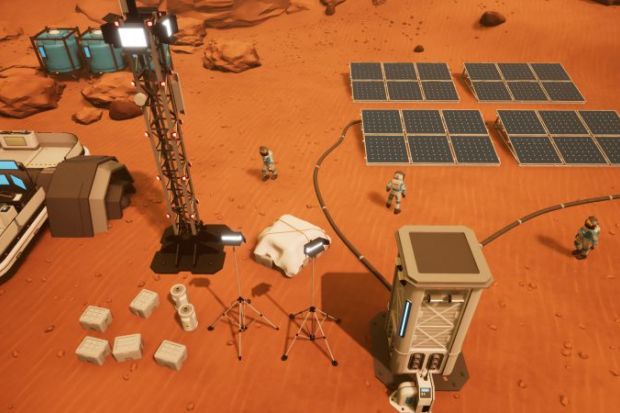Winter Hall is described by its designer, Rob McLachlan of Lost Forest Games, as “a narrative exploration game, in the style of supernatural English folk horror, about the legacy of the Black Death”. Gamers start in the Sussex countryside of the present day, but they soon slip through “several portals to the past, where they leap into the bodies of other people such as Agnes the herbalist in 1348. They experience the different perspectives of spiritual medicine and then the reaction of the church and organised religion.”
Seed is a virtual reality game where one is plunged into a lost world of “garage biotech”. The setting is a run-down plywood workshop such as those created by the amateur plant breeders of the mid-20th century, where players can mix up seeds to create new hybrids. They are then given missions to develop, for example, a new type of plant for a farmer whose crops have been ravaged by parasites and who wants to avoid the use of expensive, polluting pesticides.
And Terramars brings vividly to life the technological and psychological challenges faced by eight astronauts trying to establish a base on Mars.
These games were the three finalists – out of more than 100 submissions – in the Developing Beyond competition created by Epic Games and the Wellcome Trust. All were required to explore the theme of “transformations”, to use Epic’s Unreal Engine 4 system and, crucially, to take inspiration from genuine scientific ideas. Academic experts – and, in the case of Terramars, the senior scientific adviser to the European Astronaut Centre in Cologne – were involved in every case.
By January 2018, when the winner will receive a prize of $150,000 (£113,000), the projects will have reached the stage of “minimum viable products”, ready to seek investors, publishers or partners. They were presented as work-in-progress at an event held by the Wellcome Trust.
Piers Mitchell, lecturer in biological anthropology at the University of Cambridge, is one of the academics working on a Wellcome-funded project called After the Plague: Health and History in Medieval Cambridge, which focuses on the excavation of the St John’s Hospital cemetery. The research, he explained in his presentation, enables them to ask, “how did bubonic plague change the British population?”
It was to Dr Mitchell and his team that Mr McLachlan turned when he was developing Winter Hall.
For Agnes the herbalist, Mr McLachlan told Times Higher Education, “they gave us an idea for the recipes. There was a medieval concoction called ‘dwale’, a sedative containing opium, henbane, bile and lettuce. They also provided information on blankets as plague transmission vectors. Linen was handed down to descendants, but it potentially contained the fleas and bodily fluids that passed on the plague. We could use that social and medical history to help bring a wonderful world to life that really immerses the player.”
The Cambridge team, Mr McLachlan recalled, also made a number of suggestions about the storyline for Winter Hall: “You are an archaeologist coming to work, recently transferred to the site, and the person that you are meant to meet isn’t there. You move into a deserted site after closing time and you start getting down to work. Then the mysterious supernatural things start happening that carry you back in time.” Nonetheless, they were also very clear that it was his game and that they had no desire to insist on the kind of pedantic accuracy that could detract from the drama and excitement of it.
A rather different kind of collaboration went into the development of Seed.
Helen Curry, Peter Lipton lecturer in history of modern science and technology at Cambridge, worked on “amateur plant breeders who enjoyed tinkering with plants at home” before moving on to the history of seed banking. When Olie Kay of All Seeing Eye approached her with his plans for “a game that allows you to build new plants”, she explained, “it was as if he was making a game about my research”. She soon embraced possibilities of “another mode of dissemination, which will reach very different people from my articles or books”.
Although Mr Kay had initially envisaged a high-tech virtual reality environment for his game, he soon realised that Dr Curry’s research provided him with a much more unusual aesthetic along with many intriguing details, such as “the guy in the late 1950s who scraped radium off watch dials to use as a radioactive trigger to mutate his rosebuds”.
“We have taken that historic period and such stories to create beautiful visual vignettes,” Mr Kay explained. “We extrapolate from the science and make it appropriate for the game.”
Register to continue
Why register?
- Registration is free and only takes a moment
- Once registered, you can read 3 articles a month
- Sign up for our newsletter
Subscribe
Or subscribe for unlimited access to:
- Unlimited access to news, views, insights & reviews
- Digital editions
- Digital access to THE’s university and college rankings analysis
Already registered or a current subscriber? Login






